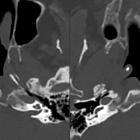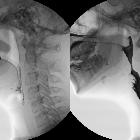eustachian tube dysfunction
 ähnliche Suchen
ähnliche Suchen siehe auch
siehe auchEustachian tube dysfunction refers to the failure of the Eustachian tube to open or close properly. Therefore, it encompasses a spectrum from patulous to obstructive pathophysiology. Eustachian tube dysfunction predisposes to chronic otomastoiditis.
Epidemiology
Eustachian tube dysfunction is estimated to be present in ~1% of the adult population.
Pathology
It has been demonstrated that equalization of middle ear pressure, and flow of contrast out of the middle ear is poor in a high percentage of patients with chronic otomastoiditis, even though only ~33% demonstrate occlusion of the Eustachian tube or tubal filling defects (e.g. polyps). Dysfunction of the tensor veli palatini muscle has also been implicated. In patients with cleft palate ~50% demonstrate conductive hearing loss as a result of abnormal muscular function.
Failure to equalize middle ear pressure can lead to negative pressure causing tympanic membrane retraction, mucoperiosteal thickening and even acquired cholesteatomas due to the aforementioned retraction of the tympanic membrane.
The converse has also be postulated; failure of the Eustachian tube to close normally (known as patulous tube syndrome) during strong inspiration (i.e. 'sniff') transmits negative pressure to the middle ear and tympanic membrane with the same sequelae as above.
Radiographic features
CT petrous temporal bone (high resolution)
It may show opacification of the middle ear cavity +/- adjacent mastoid air cells due to secretory otitis and there is usually no ossicular chain erosion or disruption unless there is a superimposed infective and/or inflammatory process .
It may show the presence of an associated mass lesion.
Treatment and prognosis
Tympanoplasty may be required to restore normal function.
Siehe auch:
- chronische Otomastoiditis
- Tuba auditiva Eustachii
- erworbenes Cholesteatom
- tympanic membrane retraction
- Gaumenspalte
- Klaffende Tuba auditiva Eustachii
und weiter:
 Assoziationen und Differentialdiagnosen zu eustachian tube dysfunction:
Assoziationen und Differentialdiagnosen zu eustachian tube dysfunction:




